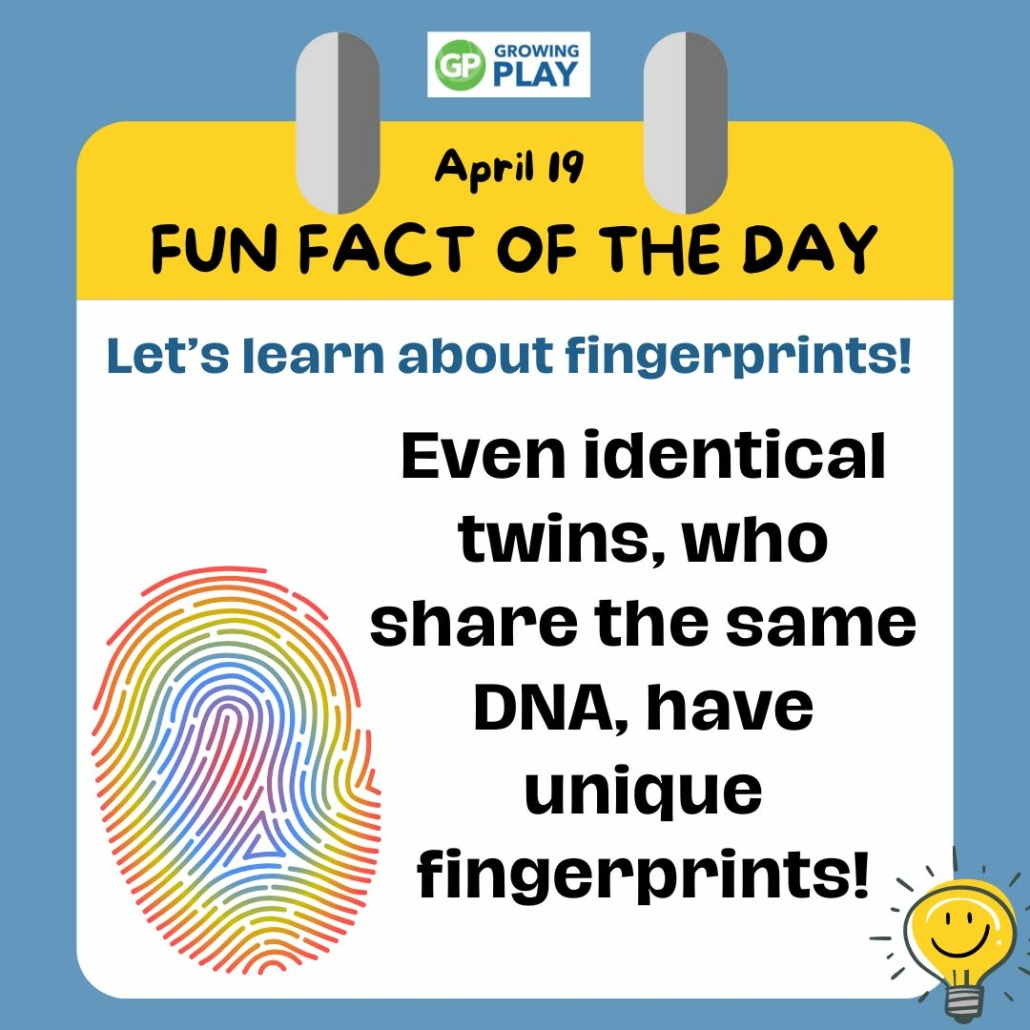April 19 – Fingerprint Facts for Kids

Welcome to April 19, a day full of fascinating discoveries about fingerprints! Did you know that every person’s fingerprints are unique, making them an excellent tool for identification? Today, learn some intriguing fingerprint facts for kids that are sure to capture the imagination of both elementary and middle school students. You can check out all of the Fact of the Day for kids here.
TEN FUN FACTS ABOUT FINGERPRINT FACTS FOR KIDS
- Identical Twins – Even identical twins, who share the same DNA, have unique fingerprints!
- Forensic Science – Forensic scientists use magnifying glasses at crime scenes to study fingerprints and help solve mysteries.
- Fingerprint Patterns – There are three main types of fingerprint patterns: loops, whorls, and arches, each with unique features like radial loops and ulnar loops.
- History of Fingerprints – The use of fingerprints dates back to ancient times for business transactions and identification, particularly in ancient Babylon and China.
- Fingerprinting Techniques – Modern methods include using ink pads to transfer a fingerprint onto a piece of paper or using cocoa powder to reveal latent prints on a glass surface.
- Science Projects – Exploring fingerprints can be a fun science project. You can learn about the friction ridge patterns that help us grip objects.
- Technology and Security – Fingerprints are used in access control systems, like unlocking a smartphone or for biometric passports.
- Alphonse Bertillon – He developed a system to identify criminals that initially included detailed descriptions and measurements, before fingerprints were used.
- Environmental Factors – The unique pattern of ridges on your fingers is influenced by environmental factors when you are still an embryo.
- Unique Identifiers – Every single fingerprint is unique, making each person’s fingerprints a powerful means of identification.

Secret Agent Pretend Play
ACTIVITY IDEAS TO CELEBRATE APRIL 19
Celebrate Fingerprint Day with these fun activities designed to engage and educate:
- Create your own fingerprint art by pressing inked fingers onto paper.
- Visit Detective Fingerprint Mission: The Case of the Missing Diamond
- Use a magnifying glass to study different patterns on the tips of your fingers.
- Conduct a “Whose Fingerprint?” game by matching prints to the correct person.
- Try lifting fingerprints from different surfaces using simple tools like tape and powder.
QUESTIONS TO THINK ABOUT FINGERPRINT FACTS FOR KIDS
Think deeper about the fascinating world of fingerprints and the science of fingerprints:
- Why do you think each person’s fingerprints are different?
- How do fingerprints help law enforcement agencies?
- Can you think of any other uses for fingerprints besides solving crimes?
- What might happen if someone had smooth fingers with no ridges?
- How do scientists use fingerprints in research beyond law enforcement?

Detective Puzzle Pack
WOULD YOU RATHER QUESTIONS ABOUT FINGERPRINTS
Spark some fun conversation with these questions:
- Would you rather have your fingerprints taken at a crime scene or use someone else’s fingerprints to unlock a mystery?
- Would you rather never have fingerprints or have fingerprints that change patterns every day?
- Would you rather be able to see everyone’s fingerprints glow in the dark or have your own fingerprints smell like chocolate?
- Would you rather use your fingerprint to unlock every door or use a traditional key?
- Would you rather have a job where you analyze fingerprints or create fake fingerprints for movies?
MORE FUN STUFF
Here are more fun ideas to help keep the kids entertained:
- Explore Fun Facts for Kids
- Engage in Secret Agent Missions – Pretend Play


